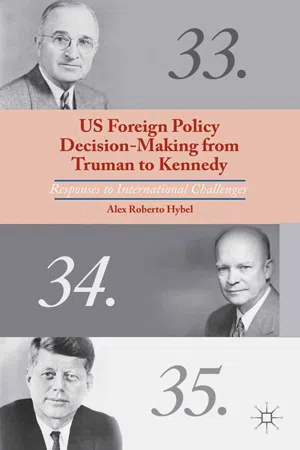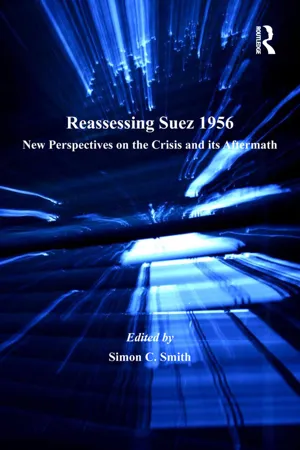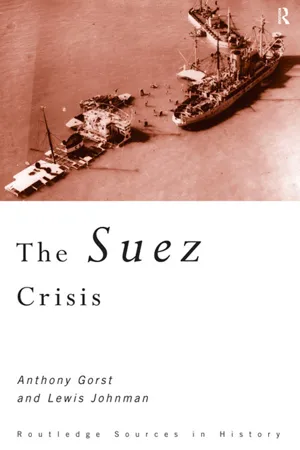History
Suez Canal Crisis
The Suez Canal Crisis, also known as the Suez Crisis, occurred in 1956 when Egypt nationalized the Suez Canal, leading to a conflict between Egypt, Israel, France, and the United Kingdom. The crisis resulted in a military intervention by the UK, France, and Israel, but international pressure, particularly from the US and USSR, forced them to withdraw, marking a shift in global power dynamics.
Written by Perlego with AI-assistance
Related key terms
7 Key excerpts on "Suez Canal Crisis"
- eBook - ePub
- Veronica M. Kitchen(Author)
- 2010(Publication Date)
- Routledge(Publisher)
The Suez Canal was essential to the economic life of Europe because it allowed goods to pass between Europe and Asia without taking the long trip around the horn of Africa. The Canal had been under British control for some time and the Suez Canal Company provided pilots to navigate ships through it. On 26 July 1956, Egyptian President Gamal Abdul Nasser nationalized the Suez Canal and the Suez Canal Company, ostensibly to help pay for the Aswan Dam project the American government had recently refused to fund. The French and British governments argued that their economic security was threatened by the nationalization, and after consulting with the Americans, called a conference in London of the eighteen principal users of the canal. The canal users sent Australian Prime Minister Robert Menzies as their representative to present Nasser with a proposal for maintaining the flow of traffic through the canal, based on the assumption that Egyptian pilots would be insufficiently trained. Nasser rejected it, but to the surprise of the eighteen powers, ships continued to pass through the canal relatively painlessly. The United States then proposed the creation of a Suez Canal Users’ Association (SCUA) to which ships would pay piloting fees until the nationalization crisis could be solved; it too floundered when it became clear to the French and the British that the Americans were unwilling to back up SCUA with the use of force. The issue was brought before the United Nations in the autumn, and by the middle of October 1956, the French, British and Egyptian foreign ministers, in consultation with Secretary General Dag Hammarskjöld, had agreed to a set of six principles to guide a settlement for the Suez Canal. The crisis looked as if it was on its way to resolution, with only the details of implementation to be worked out. Things changed, however, on 29 October 1956, when Israel invaded the Canal Zone. After issuing Israel and Egypt an ultimatum designed to be almost impossible for the Egyptians to accept, France and Britain invaded the Canal Zone in order to separate the Egyptian and Israeli combatants. The rumour at the time was that France, the United Kingdom, and Israel had colluded to plan the invasion; years later this was confirmed to be true.The Anglo-French invasion sent transatlantic relations into a tailspin. This, not the nationalization of the Canal, was the real crisis in transatlantic relations. The fact that it came at the same time as the violent Soviet suppression of the Hungarian revolution only strained relations even more. Between the day of the invasion on 29 October and the withdrawal of British forces in the first week of December, the United States went out of its way to make life difficult for its French and British allies. It repeatedly denounced them in the Security Council, and withheld oil supplies. The American Sixth Fleet launched fly-bys of French ships, and wreaked havoc on military operations (Thomas 1978:250). When the French Ambassador came to visit Dulles after the ultimatums had been issued, Dulles compared France and Britain to the Soviets in Hungary. He withdrew the comment, but his temper betrayed his perspective in the heat of the moment (Finer 1964:7). The immediate crisis was solved when Lester B.Pearson, Canada’s delegate to the United Nations, proposed the creation of the United Nations Emergency Force—an initiative for which he received the Nobel Peace Prize in 1957. The blue-helmeted troops moved into the Canal Zone at the end of the year, but relations were sorely damaged. - eBook - ePub
US Foreign Policy Decision-Making from Truman to Kennedy
Responses to International Challenges
- A. Hybel(Author)
- 2014(Publication Date)
- Palgrave Macmillan(Publisher)
Chapter 4 Dwight Eisenhower and the Suez Canal Crisis of 1956 IntroductionOn October 24, representatives of the governments of Israel, France, and Great Britain held a secret meeting in Paris, where they decided to attack Egypt to reverse President Gamal Nasser’s nationalization of the Suez Canal Company. At the meeting, the three parties agreed that Israeli forces would advance toward the Suez Canal Zone, after which France and Britain would issue an ultimatum demanding that Israel and Egypt stop fighting and accept the occupation of the canal zone by forces from the two European countries. Certain that Cairo would reject the demand, Britain and France would then launch an air attack on Egypt, followed by an invasion. On that same day, Egypt, Syria, and Jordan decided that, if one of them were to be attacked, it would be understood as an attack upon all three. Were such a situation to unfold, the three would form a unified command to repulse the attack. As these two separate covenants were being settled, the Soviet Union ordered tens of thousands of its troops to march into Budapest to end the student demonstrations that had started the day before against the Hungarian government and its Moscow-imposed policies.1Israel, Britain, and France carried out the attacks on Egypt as planned. By November 2, Egypt’s air force had been destroyed, and thousands of Egyptians had been either killed or captured. Three days later, French and British forces landed in Egypt. Soon thereafter, Moscow warned British, French, and Israeli leaders that it was prepared to send Soviet air and naval forces to protect Egypt and restore peace. Moscow simultaneously proposed to Washington that the Soviet Union and the United States join forces “to restore peace and tranquility” in the Middle East and cautioned that continued fighting could lead to another world war. - eBook - ePub
The United States, Great Britain, and Egypt, 1945-1956
Strategy and Diplomacy in the Early Cold War
- Peter L. Hahn(Author)
- 2014(Publication Date)
- The University of North Carolina Press(Publisher)
10: American Policy during the Suez Crisis, July–December 1956
The nationalization of the Suez Canal Company seriously threatened the American quest to stabilize the Middle East by undermining Western interests in the region, significantly increasing Nasser’s prestige, and portending the spread of neutralist sentiment to the benefit of the Soviet Union. Worse, nationalization provoked a sharp tactical divergence between the United States and Britain. Embittered by Nasser’s past attacks on their diminishing position in the Middle East and alarmed by his seizure of the canal company, the British decided to use force to topple him from power. American officials continued to view Nasser as a danger to Western interests but believed that the use of force against him would only facilitate Soviet infiltration of the region. Despite American objections, frustrated British leaders, in conjunction with France and Israel, ultimately attacked Egypt. That assault ruined the Anglo-American initiative to arrange an Egyptian-Israeli peace, embittered Egypt and other Arab powers toward the West, exposed the Middle East to Soviet influence, and produced a grave schism in the Anglo-American alliance.The Divergence of American and BritishPolicy toward Egypt, July-October 1956
British and American officials reacted differently to Nasser’s nationalization of the Suez Canal Company. Prime Minister Anthony Eden and others in London viewed nationalization as a threat to their economic, strategic, and political interests in the Middle East and concluded that Nasser’s overall defiant posture justified taking steps to remove him from power. They immediately decided to use force to recapture control of the canal company and to topple Nasser. President Eisenhower and Secretary of State Dulles, though regretting Nasser’s action and disturbed by his neutralist diplomacy, believed that the use of force against him would be more damaging to Western interests than nationalization. Force, they predicted, would intensify nationalism throughout the developing world and provide the Soviet Union an opportunity to gain influence in the Middle East. Calculating that the likelihood of force would dimmish as time passed, American officials implemented diplomatic initiatives that were designed to resolve the canal dispute peacefully and especially to prevent the British from resorting to hostilities. - eBook - ePub
Reassessing Suez 1956
New Perspectives on the Crisis and its Aftermath
- Simon C. Smith(Author)
- 2016(Publication Date)
- Routledge(Publisher)
At the time, Nasser spoke encouragingly of the dawn of ‘a new era of co-operation and mutual understanding’. His creation of a Suez Canal Committee the same month as the agreement was concluded commenced the planning that would lead to 26 July 1956, the start of the Suez crisis. ‘Britain’, Nasser declared in his Alexandria speech:is not to interfere in our affairs. She nationalised iron, steel, transport and maritime transport. Nobody asked her why she is nationalising them. She is free regarding her joint-stock companies and we are free regarding our joint stock companies, to nationalise what we want, to nationalise and leave alone what we want to leave alone. England has nothing to do with us and England is causing a clamour. Does she believe that we are part of the British Crown or that we belong to British imperialists? Egypt today is a free and independent state. She will guard her independence and will guard her freedom.90The charismatic Egyptian leader was determined to achieve true independence for his country, which meant gaining and keeping control of the famous waterway built by Egyptian labour once the last British troops left the Canal Zone, which they did on 13 June 1956. After nationalization, against a backdrop of over seventy years of subservience to the British, Nasser remained resolute in parrying any diplomatic solutions which smacked of colonialism. Throughout the summer, the Egyptians rejected all attempts to form an international administration, leading Britain and France, in collusion with Israel, to seek a military solution. In the process, the British nightmare of a Canal blocked for months91 finally came to pass with the Egyptians sinking ships (ironically, largely owned by the Canal Company) in retaliation for the Anglo-French invasion.1 J. Marlowe, Anglo-Egyptian Relations 1800–1953 - eBook - ePub
Suez Deconstructed
An Interactive Study in Crisis, War, and Peacemaking
- Philip Zelikow, Ernest May(Authors)
- 2018(Publication Date)
- Brookings Institution Press(Publisher)
Gamal Abdel Nasser had nationalized a private company operating in Egypt whose headquarters was in Paris and whose largest shareholder was the British government. The nationalization was due to take place anyway in 1968. In nationalizing the canal company now, Nasser promised to indemnify the shareholders according to the price of the stock at the Bourse of Paris the previous day (July 25, 1956). However, Nasser accompanied the act of nationalization by the simultaneous takeover of the Suez Canal Company’s offices in Egypt by Egyptian forces.Strictly speaking, the only international aspect of the Suez Canal was that the right of passage through the canal for all countries was guaranteed by the world’s major interested powers in 1888.4 This convention had already been violated by Egypt, well before Nasser’s nationalization speech, so there was no new violation per se. In September 1954 Israel had tested its right to use the canal. The Egyptians had confiscated the ship and imprisoned its crew for three months. (Technically speaking, Great Britain had also violated the 1888 convention in World Wars I and II when it closed the canal to various signatory powers.)Christian Pineau, a leading advocate of the “free passage” principle, emphasized that “there had to exist, we thought, sufficient means of pressure to compel Nasser not to go back on his nationalization of the Canal but on his will to control international navigation.”5As one expert has pointed out, “The fact that the character of the Suez Canal Company was French, with its principal headquarters in Paris, while the British Government was the principal shareholder, made for an Anglo-French alignment.”6 While Britain and France’s interests were interlocked, and therefore they were compelled to act together, there were a number of anomalies and tensions in the background of this situation.The canal had been built on the initiative of a Frenchman, Ferdinand de Lesseps, and in 1854 the French project was created under the name of the Compagnie universelle du canal de Suez. After the canal was opened in 1869, the British eventually edged the French out of Egypt, but then came the Entente Cordiale at the beginning of the twentieth century, and Britain and France became allies after a thousand-year rivalry. However, the ancient fault lines were still there, hardly under the surface. - eBook - ePub
- Ritchie Ovendale(Author)
- 2015(Publication Date)
- Routledge(Publisher)
CHAPTER NINEThe Suez-Sinai War of 1956
A fter the Anglo-American withdrawal from the Aswan dam venture, Nasser was probably left without any secure means of financing his scheme to bring Egypt into the modern age. But he was in a strong position domestically: an alleged 99 per cent of Egyptian voters had just elected him President. The nationalization of the Suez Canal Company had been considered earlier as a source of revenue, but even that would not provide all the necessary foreign exchange. It would, however, be something. And, probably, during the diplomatic consultations between Cairo and Moscow that immediately followed Dulles’s interview with Hussein, Russia agreed in principle to help. In any case Nasser felt that his new Egypt had been slighted. He had heard the news of the renege in the company of his fellow neutralist, Jawaharlal Nehru, with whom he had had discussions in Yugoslavia together with Marshal Tito on such subjects of interest to the three non-aligned leaders as the war in Algeria and relations between the Third World and the power blocs. Nehru had commented on the arrogance of people in the West. Nasser made secret plans to seize the Canal Company’s offices. On 26 July, speaking in Alexandria, he referred to his revolution restoring Egypt’s sense of dignity: no longer were Egyptian leaders left waiting in the offices of the British High Commissioner; in Egypt the Russian arms became Egyptian arms. He gave a history of Palestine and accused Britain, erroneously, of promoting Zionism to combat Arab nationalism. The West’s terms for the Aswan dam loan were ‘imperialism without soldiers’: with Eugene Black Nasser had felt he was sitting in front of Ferdinand de Lesseps. That was the signal for the seizure of the company’s premises. Nasser concluded by declaiming that the days of alien exploitation were over: the Suez Canal and its revenues would belong to Egypt. Nasser’s military experts had assured him that it would take Britain and France at least a month to send a military expedition.1 - eBook - ePub
- Anthony Gorst, Lewis Johnman(Authors)
- 2013(Publication Date)
- Routledge(Publisher)
The actual debates within the Security Council made no substantive progress. However, a series of meetings chaired by the Secretary-General of the United Nations Dag Hammarskjöld between Lloyd, Pineau and Fawzi were more productive. These were the first face-to-face meetings between the main protagonists since the nationalisation: after three days of often tense discussions a basis for further negotiations was proposed by Lloyd and agreed with some reservations by Fawzi and with some reluctance by Pineau. These ‘Six Principles’ were passed by the Security Council on 13 October 1956.Document 3.23 ‘Six Principles for the Future of the Canal Proposed at the United Nations Security Council, 13 October 1956 by Britain and France'Any settlement of the Suez question should meet the following requirements: 1 there should be free and open transit through the Canal without discrimination, overt or covert – this covers both political and technical aspects; 2 the sovereignty of Egypt should be respected; 3 the operation of the Canal should be insulated from the politics of any country; 4 the manner of fixing tolls and charges should be decided by agreement between Egypt and the users; 5 a fair proportion of the dues should be allotted to development;6 in case of disputes, unresolved affairs between the Suez Canal Company and the Egyptian Government should be settled by arbitration with suitable terms of reference and suitable provisions for the payment of sums found to be due.Source: Lloyd, 1978, appendix IV, p. 276Given what was to follow, it is ironic that these principles were to form the basis of the ultimate settlement of the Suez Canal dispute in 1957. The proposals, on the surface, represented a satisfactory reconciliation of the public British position and that of Egypt. What they did and could not do, however, was administer a public humiliation to Nasser that would lead to his downfall which was the sine quo non of the private British position.Although these principles were greeted by Eisenhower with an enthusiastic endorsement that this meant that the crisis was over, no agreement was reached on the system that would administer the Six Principles. None the less, this represented a considerable advance on the diplomatic deadlock of the preceding months and Eden consented to Lloyd remaining in New York to explore further avenues of progress with Fawzi, the ultimate aim being that if sufficient progress had been made the foreign ministers should meet again at the end of the month. This was potentially embarrassing as Eden had delivered, on the very same day as the passage of the six Principles by the Security Council, a speech to the Tory Party conference at Llandudno which, in refusing to rule out the use of force, was, as Carlton notes, greeted with such great enthusiasm by the delegates that the Prime Minister must have realised that any compromise solution, such as Lloyd was working towards in New York, would be deeply unpopular in the Conservative Party' (Carlton, 1988, p. 58).
Learn about this page
Index pages curate the most relevant extracts from our library of academic textbooks. They’ve been created using an in-house natural language model (NLM), each adding context and meaning to key research topics.






